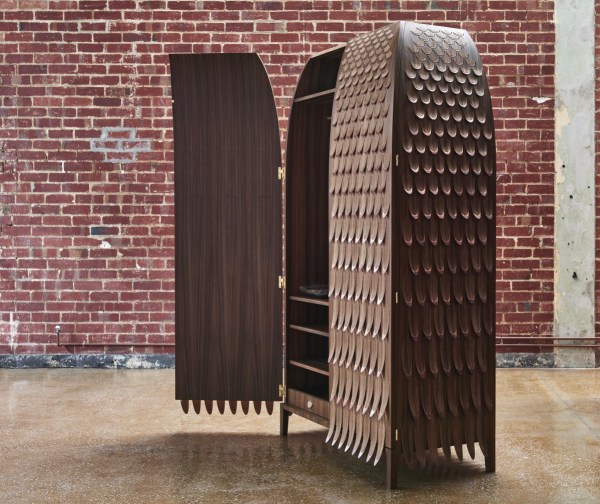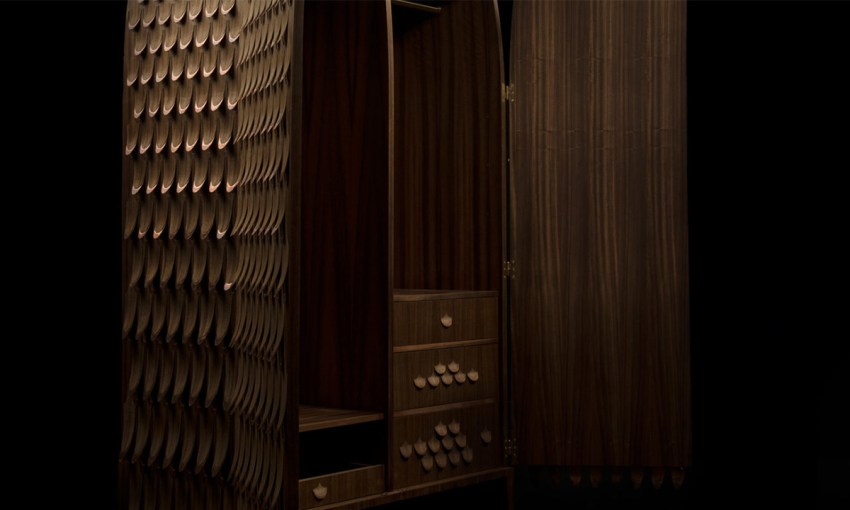Ahead of tomorrow's announcement of the inaugural winner of the Ramsay Art Prize, we speak with finalist Trent Jansen – whose Pankalangu Wardrobe blurs the line between art and design.
An outsider’s chance
Trent Jansen is one of 21 finalists in the running to win the inaugural Ramsay Art Prize, Australia’s richest contemporary art prize for artists under 40, which will be announced tomorrow (Friday, May 26th).
In the world of contemporary art, Trent’s entry is strangely functional – it’s a wardrobe.
Trent’s wardrobe is made from hand-glued veneers of Queensland walnut and hand-bent shards of copper. The piece takes on the form of the Aboriginal creature the Pankalangu, which is visible in the Australian bush only when the rain glistens on its body. It is, quite clearly, more than a piece of furniture.

Detail of the Pankalangu Wardrobe – glistening
Trent believes his entry in the Ramsay Art Prize is a melding of culture. He wants non-Indigenous Australians to more closely relate to the history of this land and its people, and to embrace it as an integral element of national identity.
“It’s about bridging a cultural gap and providing some narratives we can all associate with that can tie us together in our idea of who we are instead of dividing us,” Trent says.
“It’s something that is part of my identity because of the place that I live in and the history that I’m a part of. I’d like it to be part of my national identity and identity more broadly.
“I really feel like that identity and a lot of the narratives and rituals are a big part of what it is to be Australian in a contemporary sense and it would be really lovely if more Australians could have mainstream access to that.
“I think it would give us a more solid connection with this place and a longer connection with this place and the culture that’s existed here for so long.”
Originally from small coastal town Kiama, south of Sydney, Trent moved north to educate himself in design before his career took a few serious leaps forward.
In 2008, he was awarded an internship with renowned Dutch design company Moooi in Amsterdam, then won the opportunity to work alongside famed Italian designer Massimo Morozzi in 2010.
Jansen says that in the world of design, his association with Moooi and Morozzi have certainly given him a leg up.
But it’s the world of fine art in which Trent now finds himself – as a finalist for the Ramsay Art Prize.

He considers himself the “outsider of all outsiders” to take out the prize, but not due to his design background. Trent doesn’t believe in a stark distinction between design and art.
“There are some things that are definitely design, like high-production industrial design and in my field there are some things that are definitely art, but the area that sort of sits on that continuum midpoint is really interesting for me,” he says.
“They’re functional objects and functional objects come with their own language. Because they have that language they’re much easier to use as communicative devices.
“A person understands what a chair, or a wardrobe, or whatever is for – so they have this immediate recognition when they see the object and you can often use that as part of your narrative or message or advocacy or whatever it is you’re trying to do with the work. Whereas art can start at nothing and has to inject all of these known symbols in order to be understood or in order for a message to be conveyed.
“I like the way design can use its function as part of the delivery of a narrative.”
Trent will head north next month for a residency based at Fitzroy Crossing in the Kimberly Ranges, where he’ll collaborate with local Indigenous artists to work on more creature-like objects based on stories from that region.





